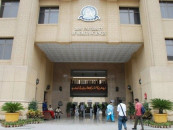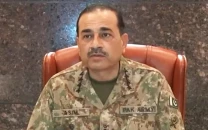Public health: If the past is any guide, boosting healthcare is a tall order
Not a single political party has provided a roadmap on how they intend to achieve proposed targets.

Not a single political party has provided a roadmap on how they intend to achieve proposed targets.
Easy access to better healthcare services is a distant dream for most Pakistanis. Every electoral cycle, the majority of political parties make tall claims of improving this sector but, once in power, these promises are conveniently put on the back shelf.
This time, too, an analysis of the political manifestos reveals that almost all the major parties have illustrated their full commitment, on paper, to the improvement of the healthcare system. However, not one among them could provide a roadmap to show how they intend to achieve the proposed targets.
Health budget
Assertions to raise the health budget and equip institutes with modern technology have been made, but just how this will be done, given the financial situation, remains to be seen.
In its manifesto, Pakistan Muslim League-Nawaz (PML-N) said it would raise the health budget to at least 2% of the GDP by 2018. In this manner, it would also achieve a three-fold increase in the overall expenditure on health. These points are in line with UN recommendations.
In a similar vein, Pakistan Tehreek-e-Insaf (PTI) claimed to ‘progressively double state spending on health’, while the Muttahida Qaumi Movement (MQM) promised to increased expenditure from 0.6% to 5% of the GDP, all in a span of five years.
Furthermore, the Awami National Party (ANP) expressed its intention to allocate at least 6% of the GDP for health, while the Pakistan Peoples Party (PPP) also proposed an increase in health spending to 5% of consolidated government spending.
Somewhat controversially, both PML-N and PTI mentioned plans to make all government hospitals autonomous. This would make hospitals responsible for generating their own funds, thus depriving poor patients of free healthcare services, and depriving employees of their rights as government workers.
Tackling preventable epidemics
PML-N, PTI, MQM and the PPP all claimed they would ensure 100% immunisation of children against preventable diseases. Although such a claim is admirable in theory, the 100% figure implies that every single child in the country will be vaccinated. Keeping in mind the conflict zones and the inaccessible terrains, this is an impossible endeavour. Current statistics tend to support this view.
In the North and South Waziristan tribal agencies, 260,000 children have yet to be vaccinated, owing to the ban on polio vaccination in place since 2012. Moreover, during the first national anti-polio campaign of 2013, over 1.4 million children missed the vaccinations because of the law and order situation.
Infant mortality and malnutrition
The mainstream parties also promised to reduce the maternal and infant mortality rate, which is another major health issue. However, it will be a real challenge for the next government to achieve this target, because there are multiple hurdles that need to be addressed, including social taboos, cultural norms, absence of the basic healthcare system in remote areas, untrained midwives, poor communication, and illiteracy.
The same problems will have to be dealt with in reducing population growth, another aim the parties listed.
On the other hand, almost all manifestos ignored the malnutrition issue, one of the root causes of maternal and infant mortality. In Pakistan, almost half the children under the age of five are chronically malnourished.
Should we be optimistic?
The healthcare situation can be improved by building on the primary healthcare services. In this vein, all political parties pledged to upgrade basic healthcare units (BHUs) and rural healthcare centre.
However, considering PML-N’s performance in Punjab during its five year tenure, it remains to be seen how it will live up to the tall claims made in its manifesto.
Currently, 98 BHUs in the Rawalpindi districts are facing an acute shortage of medicines. Major public hospitals in the city have stopped providing treatment to the hepatitis patients due to non-availability of interferon injections. More jarringly still, the coverage of routine immunisation in Punjab is around 56%, one of the major reasons behind the recent measles outbreak that claimed over 54 lives in the province. Similarly, the PPP also promised to improve the sector, but it did very little during its term.
With such past examples, it is difficult to be optimistic, despite the enthusiastic manifestos. Today, Pakistan greatly lags behind on 25 Millennium Development Goals. Even after the devolution of the health ministry to the provinces, under the 18th Amendment, the sector is suffering.
Published in The Express Tribune, May 5th, 2013.



















COMMENTS
Comments are moderated and generally will be posted if they are on-topic and not abusive.
For more information, please see our Comments FAQ